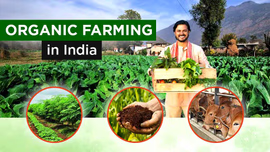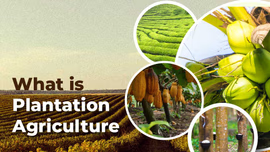How to Set Up a Dragon Fruit Farm in India – Process, Economics and Schemes

Table of Content
- Introduction
- Dragon Fruit Production in India
- Why Should You Start Dragon Fruit Farm in India?
- Dragon fruit cultivation in India
- Economics of Dragon Fruit Farming
- Government Support to Promote Dragon Fruit Farming
Introduction
Dragon fruit, a vibrant red-purple sweet fruit often gets popular for its healthy properties and during the dengue outbreak in India.
Dragon fruit’s health benefits in combination with its pricing in the market, low maintenance, and high demand makes the dragon fruit farming a profitable business in India. So, we will talk in-depth about dragon fruit cultivation in India.
Before, we see the dragon fruit production figures in India, it is necessary for you to understand what a dragon fruit and its key characteristics is.
Th dragon fruit family belongs to the climbing cactus vine species. It is also known as Kamalam or Strawberry Pear and is widely popular as Pitaya, globally. It has been called “Wonderous Fruit of the 21st Century”.
Dragon Fruit: Its Varieties, Production and Region of Cultivation
Depending upon their unique appearance, mainly three dragon fruit varieties are cultivated in India.
- Red skin with white pulp
- Red skin with red pulp
- Yellow skin with white pulp
Now, let us see the dragon fruit production figures in India.
Since its introduction in the low rainfall regions of India in late 1990, the area under dragon fruit cultivation has increased from 0.5 hectares in 1990 to 3,085 hectares in 2020. The estimates are as per a report of National Institute of Abiotic Stress Management (NIASM) under the Indian Council of Agricultural Research (ICAR).
Further, the dragon fruit production in India as per latest estimates stood at 12,113.4 tonnes in 2020.
If you want to know where is dragon fruit grown in India, then the top 5 dragon fruit producing states in India are Gujarat, Karnataka, Maharashtra, West Bengal, and Tamil Nadu. Gujarat with a share of 34% of total dragon fruit production holds the number 1 position.
Today, the dragon fruit plantation has spread to states like Uttar Pradesh, Rajasthan, and North-Eastern states of Nagaland and Mizoram.
Why Should You Start a Dragon Fruit Farm in India?
If you want to start a dragon fruit farm in India, then there are certain advantages of starting dragon fruit farming. These are:
- The cultivation of dragon fruit requires low water and nutrients.
- They can be easily cultivated in the regions that are less fertile, barren, and prone to droughts.
- They relatively require less resources to establish and maintain the dragon fruit orchard.
- They are a long-lived plant with a commercial life of up to 20 years and their fruits can be harvested multiple times in a year.
- The benefit to cost ratio of these fruits is high compared to other tropical fruits.
- Many value-added products can be prepared from the pulp of dragon fruit. These include jam, juice, jelly, wine, etc.
- Finally, they have the potential to give quick returns on investment as you can start production in the second year and full production in five years of dragon fruit plantation.
Dragon Fruit Cultivation in India
Now, you know the advantages of dragon fruit farming, let us see how to grow dragon fruit in India, what are dragon fruit growing conditions, and how long does dragon fruit take to grow.
Climate Requirement for Dragon Fruit
Dragon fruit cultivation requires the agro-climatic conditions of tropical and sub-tropical regions. Some of the growing conditions are:
- Like most climbing cacti, they grow well in shaded and semi-shaded positions under large canopies.
- They require an altitude of 1700 m and rainfall ranging from 500 – 1500 mm. The ideal temperature to grow dragon fruit ranges from 20°C to 30°C and relative humidity levels should be good.
- They can be cultivated in a wide range of soils, which are free of excess moisture. The soil can be slightly acidic with a pH value of 5.5 – 6.0 and loamy, which are rich in organic matter.
Land Preparation for Dragon Fruit
Dragon fruit plants have a shallow root with most of the roots lying on the soil depth less than 40 cm deep. Thus, land preparation for dragon fruit requires ploughing until the soil has a fine tilth, is weed free and is fine for sufficient drainage. In addition, to increase soil fertility apply some compost.
Dragon Fruit Propagation
The propagation of dragon fruit requires vegetative means like stem cutting. For effective propagation either cut the entire stem or a segment of plant measuring 15 -30 cm.
Treat the cut stem with fungicide to prevent diseases like rot and plant it after it has been dried in dry and cool area for 5 – 7 days.
These dry stems are then planted in a 12 X 30 cm polyethylene bag containing soil, manure, and sand in 1:1:1 ratio. Avoid the deposition of excess moisture and the rooted cuttings are ready to be planted in 30 – 40 days in the main field.
Dragon Fruit Plantation
The rooted cuttings of dragon fruit are usually planted in the main field during July to August because dragon fruit cultivation requires an open area with full sunlight.
The space between two plants in a single post planting system must be 3 X 3 meters. The plants are allowed to branch and hang down from a vertical pole of height 1.5 – 2 meters. Plant the dragon fruits near the poles so that they can climb easily and the number of plants per pole should be 2 -4 plants.
The dragon fruit season in India is from June to October every year. Therefore, planting must start in June – August so that fruiting starts between July and October.
Training Required for Dragon Fruit Plant
Dragon fruits are climbing cacti, and the vines grow very fast producing thick dense branches initially. Thus, restrict the lateral shoots and allow only 2-3 stems to grow through tying and regular trimming.
Also, reduce the number of branches to 30 – 50 by trimming the unwanted branches, which is known as production training.
Furthermore, erect a strong concrete column to support the vine canopy of more than 100 kg.
Fertiliser Management for Dragon Fruit
Dragon fruit needs efficient application of fertiliser and manure for higher yield. In the initial year, you need to apply a larger amount of nitrogen (N) and in later years a larger amount of phosphorus (P) and potassium (K). Thus, you need to apply fertiliser dose of N 450-gram, P 350-gram, and K 300-gram per plant per pole for optimum yield of dragon fruit.
Organic manure or compost plays a critical role in the growth of dragon fruits. Thus, you need to apply 15 –20 kg of farmyard manure per plant per year.
Irrigation Requirement of Dragon Fruits
The roots of dragon fruit are shallow and are concentrated at 15 – 30 cm soil depth. Therefore, to provide adequate water during dry season irrigation is a must. The most effective irrigation method for growth and yield of dragon fruit is drip irrigation. You need to give around 2-4 litres of water and the frequency should be twice per week per plant.
Pest and Disease Management
Dragon fruit is relatively less prone to pests and diseases. Still pests such as aphids, termites and fruit flies are found to affect the fruit. To prevent the fruit fly use pheromone traps in the dragon fruit orchard.
Further, spray fungicide to prevent fungal diseases like rot that develop during summer when the humidity levels are high.
Dragon Fruit Harvesting
The dragon fruit harvesting time is from June to September. The dragon fruit plant starts giving fruits after 12-15 months of planting. The harvesting can start 30 – 35 days after flowering and can be done 3-4 times in a month.
The average yield from the single post is realized about 30 to 35 kgs from the three years old planting. On average, dragon fruit yield is 8-10 tonnes per hectare per year.
Economics of Dragon Fruit Farming
Dragon fruit is a profitable venture requiring an initial investment of INR 8 – 9 lakhs, which includes the cost of planting material, cost of land, cost of drip irrigation, labour cost, and manure cost, among others. Now, its cultivation does not require intensive management or inter-cultural operations. This also helps save on the cost of cultivation.
Dragon fruit today has great demand in the market and thus commands a high retails price of Rs 100-150 per kg. You can expect to start earning income during the second year, around INR 4 lakh per hectare during third year, INR 6 – 7 lakhs from the fourth year and above INR 10 lakhs from the fifth year onwards.
If we talk of the benefit to cost ratio of cultivating dragon fruit, it comes to 2.58.
Government Support to Promote Dragon Fruit Farming
Dragon fruit cultivation is increasingly popular because of its high market demand and economic value. Yet the production in India is not self-sufficient and still we import a large quantity of dragon fruits. Thus, to reduce imports and increase the production capacity, the Indian government is doing following to promote dragon farming:
- It has prepared a roadmap under the Mission for Integrated Development of Horticulture (MIDH) to promote the cultivation of dragon fruits in potential areas.
- Under MIDH, the government plans to increase the area under dragon fruit cultivation to 50,000 hectares in five years.
- It has established a Centre of Excellence for Dragon Fruit with a focus on production, post-harvest and value addition.
- Haryana and Gujarat government have been offering incentives and grants to farmers for planting dragon fruits.
Frequently Asked Questions On How to Set Up a Dragon Fruit Farm in India – Process, Economics and Schemes
1. Is dragon fruit farming profitable?
Yes, dragon fruit farming is profitable as you can start earning more than INR 10 lakhs from 5th year onward with an initial investment of INR 8 – 9 lakhs. The benefit to cost ratio is 2.58.
2. Why is dragon fruit so expensive?
Dragon fruit is expensive because of its high market demand than supply.
3. Which soil is best for dragon fruit?
Acidic soil with a pH value of 5.5 – 6.0 and loamy soil rich in organic matter is best for dragon fruit cultivation.
4. What is rich in dragon fruit?
Dragon fruit is rich in fibres, antioxidants, and Vitamin C.
5. What is the future of dragon fruit farming in India?
With the government aiming to bring 50,000 hectares under dragon fruit cultivation, the future of dragon fruit farming is bright.
6. What is the best climate for dragon fruit?
Dragon fruit grows well in the warm and humid climate of tropical and sub-tropical regions.


Related Blogs












